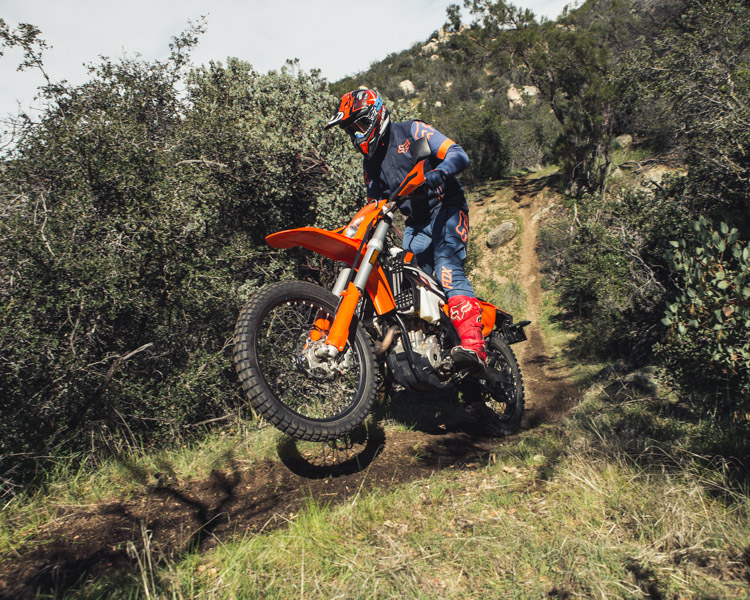2017 KTM EXC Four-Stroke Riding Impression
KTM has been on top of the world with its street legal dirt bikes in the EXC line. They have been the lightest and closest to full-on competition race bikes as the law will allow. But now the Austrian brand has taken the EXC line one step further and added the 250cc bike back to the mix. Dirt Bike Test took all three bikes out for an exhaustive one-day impression to let you know what is new in the EXC world and where the target has been moved to.
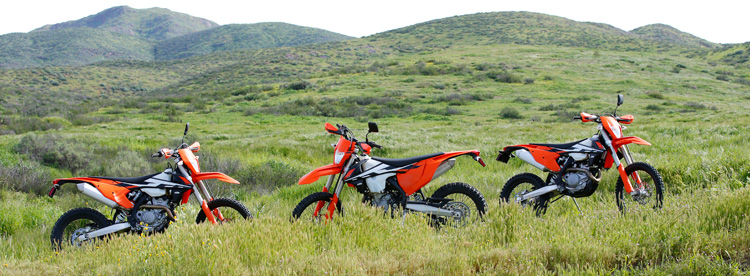
Big Changes everywhere.
The 2017 EXCs are basically based right off of the companies SX motocross and supercross bikes but truth be told these bikes actually have more R&D time in them to get them right. Most of it comes down to making the bikes legal for the different regulations they need to pass in different countries, each with a slightly different issue. But working off a base with such a high performance level is a great place to start. Not getting sidetracked and adding ridiculous amounts of weight or losing performance in search of cost cutting measures seems to take a very high priority at KTM.
Both the 350 and the 500 are claimed to weigh in at 15 pounds lighter due to the smaller and more compact engine designs along with all of the chassis changes that the SX and XC bikes received last year. We will weigh these bikes on our scales in the near future for an accurate weight. Additionally, these bikes use the PDS linkageless rear suspension system and also the new 48 Explor fork. KTM has a way of using so many of the same parts on all of the bikes but changing just the right things so the bikes work properly. Things like cast triple clamps and raising the footpeg height, lowering the seat and having a common airbox and sub-frame design common to all the full sized dirt bikes. Well the seat is an issue and we’ll get to that later.

So good that KTM dropped the XC-W four-strokes.
A lot of riders were worried that with the XC-W four-stroke gone they would not have a single-track off-road only bike to ride. Well with regulations on emissions so tight for anything that is not a competition bike, there is really little difference between an EXC and an XC-W, especially in the engine. Sure there are extra lights, but those are easy to remove. In California, a dealer can easily get you a green sticker and not a license plate if you desire.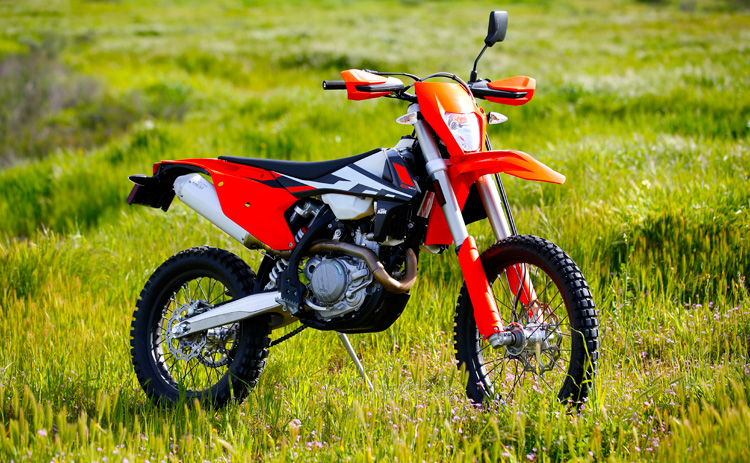
In doing this, KTM really worked on delivering the bikes in a way that they were ready to ride off-road, especially the final drive gearing. In the past, the bikes needed to be re-geared for any off-road riding to get the ratios closer together and to make first gear low enough to be useful. They really did not to have to do much else other than keep the performance that the chassis and suspension already have built in. The restrictions that are required for sound and emissions are so similar the engines would be delivered in the same tune anyways. And if you are worried about how they run, don’t be. In fact before you go and start looking for stuff to rip out and remove, ride the bike.
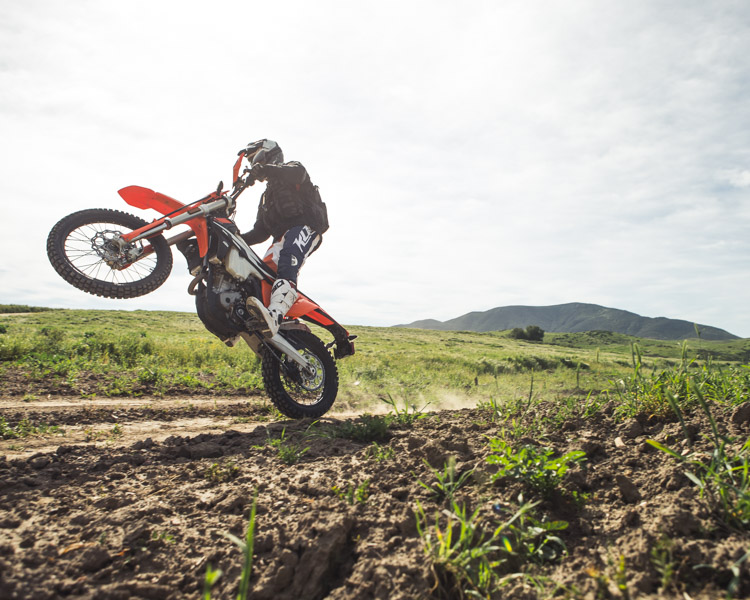
You can ride them box stock–We did.
It has become expected that there is a bunch of goofy stuff added to an EXC to make it quiet. Well aside from the tires, these KTMs are pretty spot on. Yes, the Continental tires are great on the road and will be OK off the pavement, but only just OK when compared to a real knobby-type tire. There is the muffler that has additional baffling but we know from experience in modifying and swapping them (for competition use of course) that the biggest change is the reduction in heat from the whole exhaust system and even the engine will run a little cooler.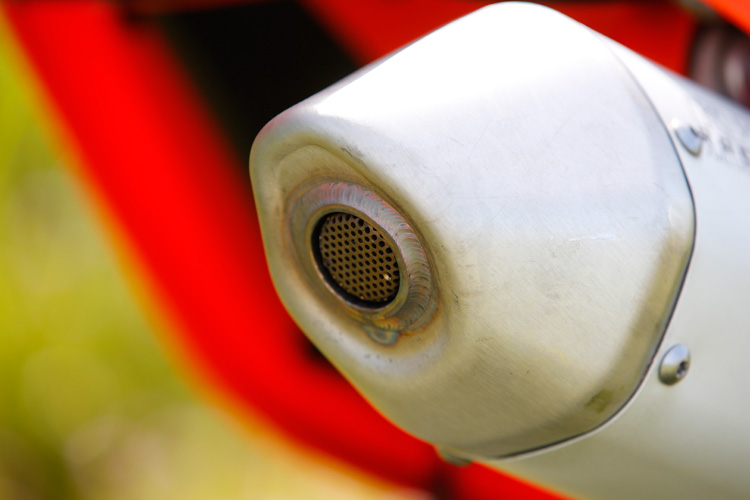
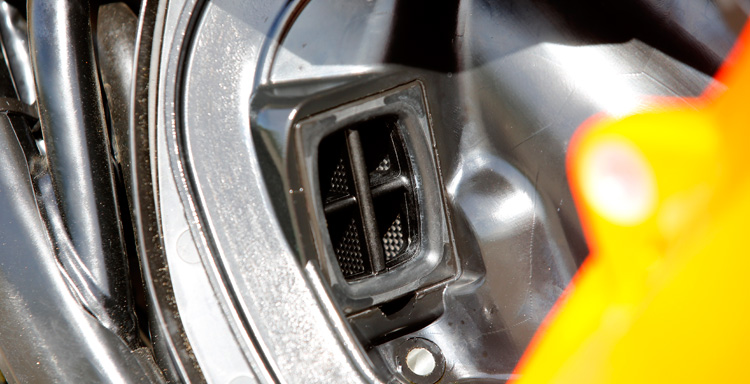
The trick to all of this is the ingenious use of a reed valve in the air box boot called the Velocity Focused Intake. It cuts a significant amount of noise and most would think it is limiting. But this part was being tested by the race team for power before it was ever considered for sound and we would not be surprised to see it make it’s way onto competition bikes soon. In use it does not let noise back out but also makes the pressures in the intake tract more consistent allowing a better tuning of the fuel mapping. Especially in trailing throttle situations. These bikes never backfired or popped one bit, a huge annoyance on the older bikes that took lots of tuning to make go away.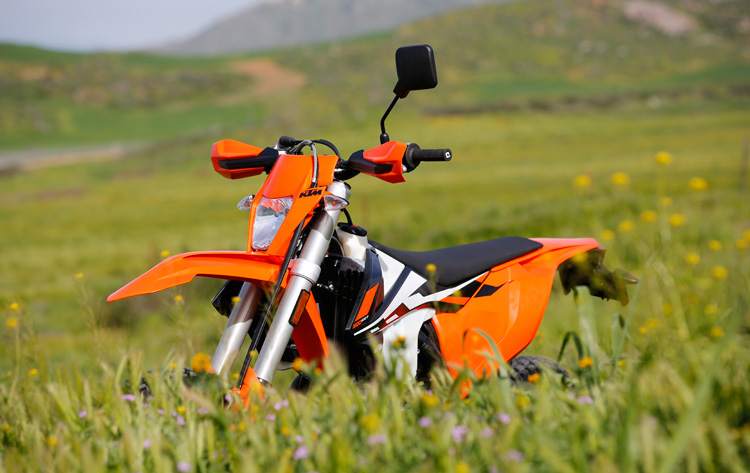
So where are all the emissions parts? Tucked into the frame downtube so you can’t even see them anymore.
If there is one thing that you might need to change it would be the rear license plate bracket. An easy fix would be to take a link out of the chain to move the rear away from the flapping part. This use to be a common thing but the 2013-2016 EXCs did not need any modification here.
Lighter, a lot lighter.
These bikes (350, 500) are close to 15 pounds lighter than the bikes they replaced, putting them in the weight category of motocross bikes. Pounds are shaved off of every part and the overall is pretty impressive. So much so that the bikes feel lighter in just moving them around. When running, the rotational stuff is lighter and changed so the bikes have a lighter feel all the time and especially when revving. We had an older 500 along on our ride and it was very obvious, especially in the tight stuff.
The biggest difference in the way the three EXCs feel is in the weight, as you’d expect. The 350, in the middle, is exceedingly light and flickable but using it as a base it is surprising how much lighter the 250 feels. For comparison, the new 500 feels a lot more like an older 350 in weight feel. It still gains some mass when you get on the gas, but when you get aggressive the bike holds onto a lot more of the agile and light feel than in the past. Our bikes have accessory plastic skid plates attached to them. The new frame has inserts in it for skid plate mounting and with light bikes choose skid plates wisely as that mounting can change the way the bikes handle.

Power.
Power output on all three of these bikes is pretty impressive for their respective displacements. We were initially very skeptical about the 250cc EXC making a comeback–But did it ever. It does not have any flywheel effect at all, but it does have surprising torque if the throttle is even just barely cracked. The bike then pulls with way more authority than any 250cc most would be familiar with. In fact the only other 250cc bike we can think of to compare it to would be the liquid-cooled Yamaha WR250X dual-purpose bike. The KTM revs out plenty far but its rev limit is shy of where we know KTMs 250cc four-strokes can rev. Max power will have the bike running easily at street speeds and pacing traffic using revs. It requires a downshift on steeper hills but a lot less than we thought it would. The gearing in the 250 was spot on and it ran into the 80 MPH range full noise.
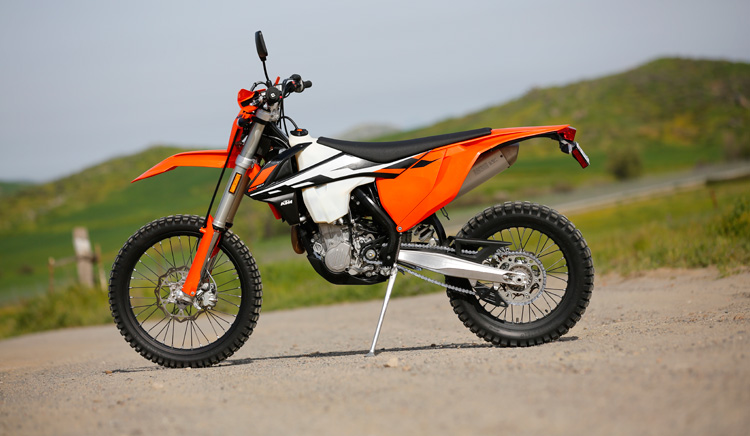 The 350 was as expected a fine blend of having some grunt in the low end and then a long and willing power spread that can chug but still prefers revving. The ability of the bike to torque down without a downshift or respond back with just throttle roll-on was definitely improved over previous 350cc versions. And on the other side it revved more free on top and pulled a little harder than we remember for a fully compliant engine. Our heavier riders struggled with being between 1st and 2nd gear in tighter conditions and all felt the 350 did not have a tall enough sixth gear for road riding. Could be an easy rear sprocket change.
The 350 was as expected a fine blend of having some grunt in the low end and then a long and willing power spread that can chug but still prefers revving. The ability of the bike to torque down without a downshift or respond back with just throttle roll-on was definitely improved over previous 350cc versions. And on the other side it revved more free on top and pulled a little harder than we remember for a fully compliant engine. Our heavier riders struggled with being between 1st and 2nd gear in tighter conditions and all felt the 350 did not have a tall enough sixth gear for road riding. Could be an easy rear sprocket change.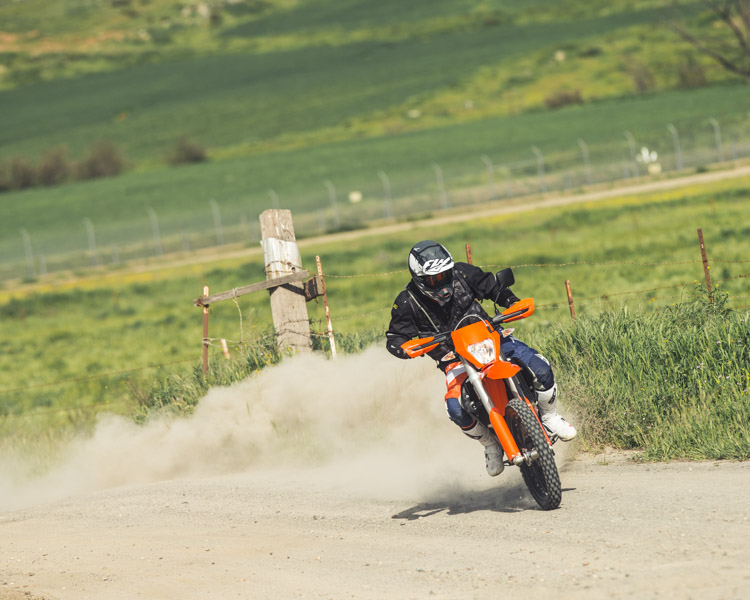
The 500 actually got a little less chunky on the bottom and the changes to the intake tract may be responsible for this. It didn’t really need power here anyways, it has plenty. Then it is very smooth and so linear as it revs out way farther than a 500 should. The gearing was spot on and we even complimented the bike for having what feels like an overdrive sixth when you shift into it. It will easily loft the front wheel in lower gear roll-ons and has a reduced compression braking feeling in comparison to the past. We did not have the space to find out but we are sure this bike will easily go over 100 MPH stock.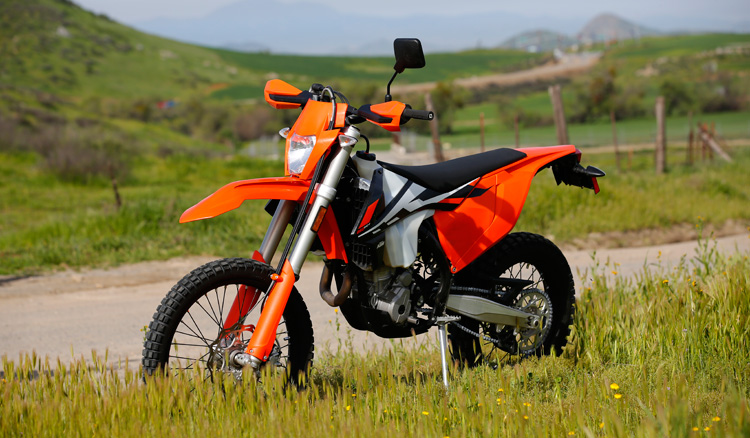
All the bikes are very quiet and the fuel mapping is not lean feeling in any way. We had less stalling issues than we have ever had on compliant bikes. There was never a backfire or deceleration pop which was both impressive and relieving as that is very annoying while riding. The cooling fans did come on in tighter trail riding where we were using the clutches and moving slowly but we did not lose any coolant. And the bikes go hot enough to get the gas boiling so it was abusive- if only a bit.
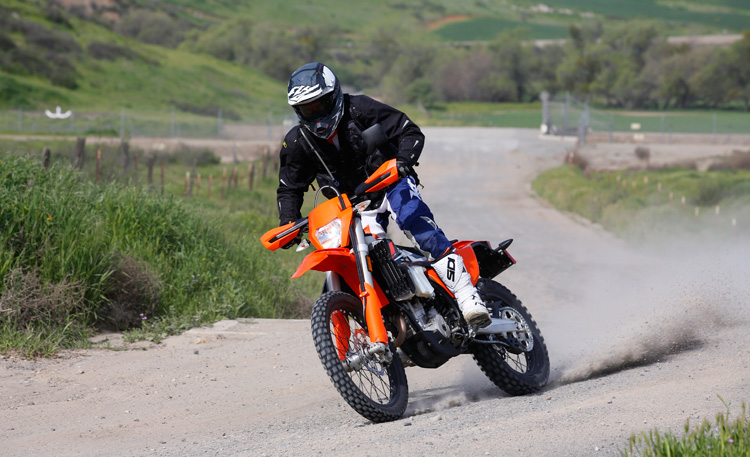
Stiffer chassis and handling nature.
The first thing most riders noticed about the bikes was the relatively stiff initial setting of the suspension and the stiffer nature of the chassis. A lot of times lighter bikes have a stiffer or more dancy feeling and these KTM’s are no different. And the 250 and 350 let the rider feel it more than the 500. But not only is this the trend of where bikes are going in off-road (stiffer) but these bikes are meant to be “ready to race” and the chassis is as good as anything out there for single-track type racing if needed. The marketing materials talk about a stiffer torsional frame (twisting) with more lateral rigidity (straight on) and we agree in feeling. It can be a little too stiff feeling on washboards or choppy bumps on dirt roads, even when the suspension is working perfectly. There is a bit of a jar that comes through the bars and the footpegs and gives the rider some of the bump. But this stiffness also promotes a very connected feeling to the bike and lets you know what is going on under the wheels.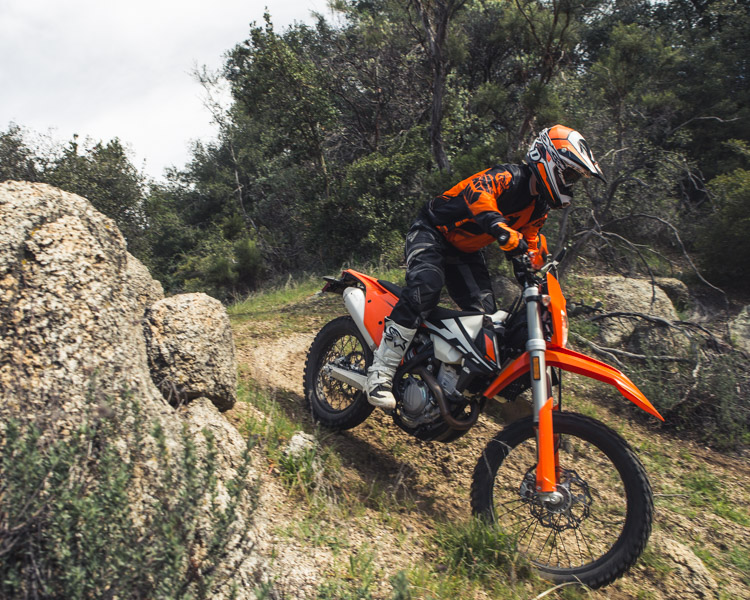
Of note is the slightly higher footpeg which can easily be changed to a lower part if the rider feels the need. Most of our guys felt that need. Or have a seat with some more padding and a little height. Or both.
Better suspension.
The new WP suspension parts are some of the best PDS and open-cartridge ever delivered on any KTM. You have to get past some of the perceptions of the smaller sized pistons and ledd adjustments being cost cutting features and just ride the bike. The suspension, especially the front fork, is simple to adjust without tools and the adjustments do work. Having compression on one side and rebound on the other is not like it was 20-years ago when it didn’t work quite right. Now the forks have better materials and still use a base valve with a bypass for the oil in the direction each side is working in.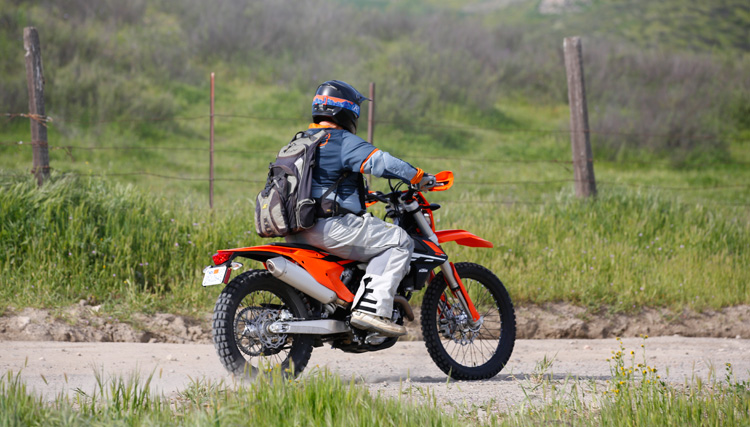
Out back the shock uses a similar sized piston as the linkage equipped bikes but the secondary PDS piston does the work a linkage might be doing for progression. Likewise, KTM has gone back to the use of a progressive spring which works better in conjunction with the new leverage ratio on the shock. The 250 and 350 have the same spring rate and the 500 is stiffer in springs. Valving is also different on the 500.
Like we felt in the chassis, the EXC holds itself up better than in the past and this also contributes to the stiffer feeling in the bike. It is still plush in nature, especially when compared to a motocross type setting but it feels like there is so much less wallow and less use of stroke most of the time. The springs hold the bike up better and the valving starts out stiffer and progressively ramps up quicker and stiffer than in the past. It isn’t motocross but you can jump the bike with more confidence than in the past.
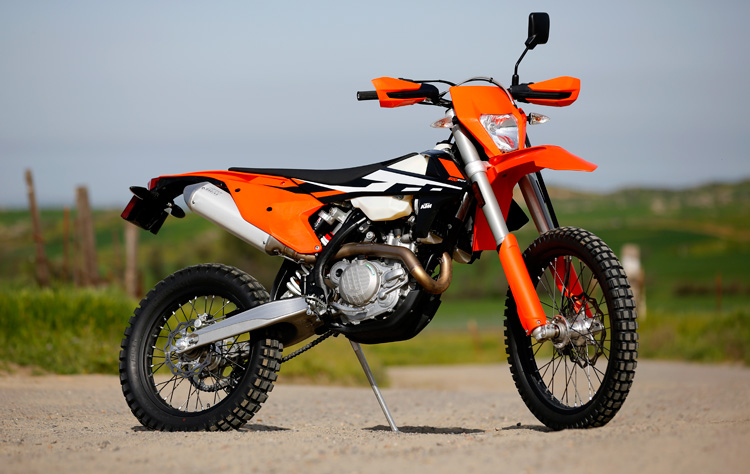
What we didn’t like.
Straight up the seat offers very little padding and will have your but hating it in 30-minutes or less. There just isn’t any foam in the front or especially in the back. The price of a lower seat height. We also tore the license plate off one of the bikes is some choppy bumps. The fender and the holder are a little flimsy and the wheel is pretty far back in the swingarm making it easier for the tire to grab at it. Our heavier riders were between gears a lot (1st and 2nd) on the 350 in tight trails and everyone felt the 350 ran out of gearing a little too quick. Neither of the other bikes had an issue at all. They all vibrate a little when compared to most and more street oriented bikes. But for dirt bikes they don’t vibrate much at all. And a lot of it is caused by the tire having the valve stem and the rim lock on the same side of the wheel, not offset 180-degrees.
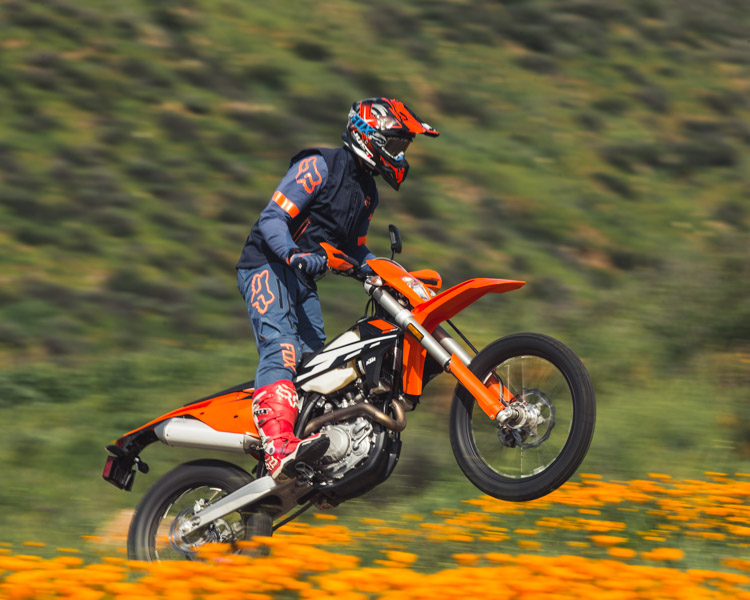 Incredible.
Incredible.
If you don’t plan on buying one of these bikes, don’t ride one. We gave that warning about the previous version back in 2012 and we are issuing that warning again. Even if you have a now non-current EXC you will be baffled at how to change your bike to have this fresh and new higher performance feel. We are hoping to get one of the bikes for a full test where we can learn about some deeper lingering questions including the maintenance and durability of the new bikes as well as how they might respond to some modifications.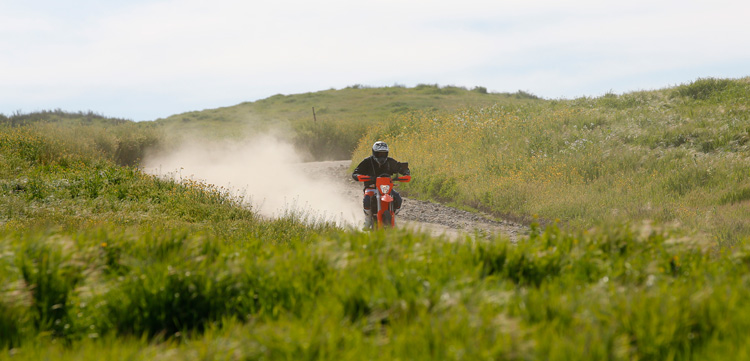
Support Dirt Bike Test By Shopping Through The Links Beolw:
